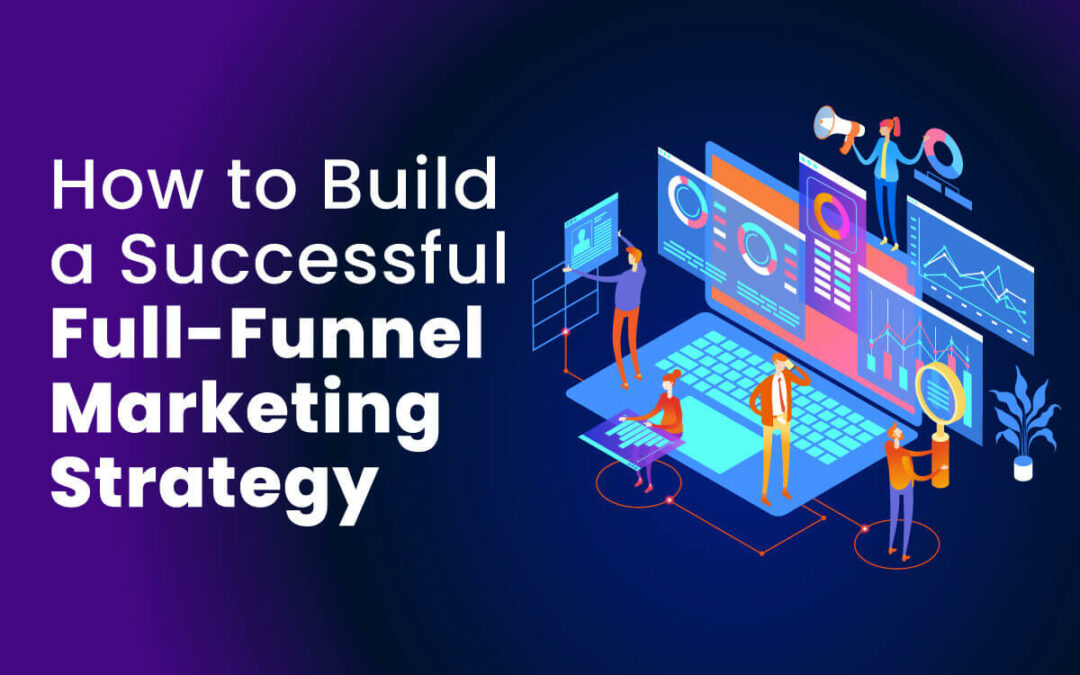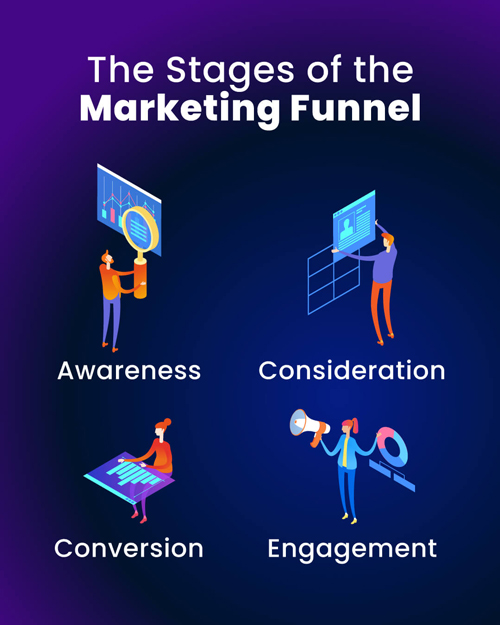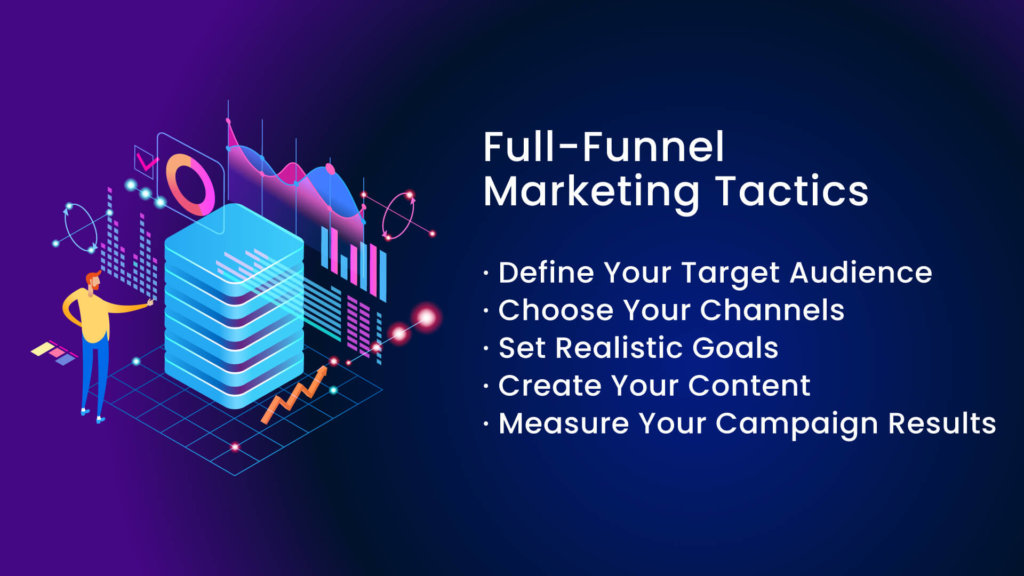In today’s competitive market, the companies with the best marketing strategies win. With the explosion of online marketing over the past few decades, there are more advertising options than ever before. There are always untapped, new audiences to sell to. It’s up to your marketing team to find them and convince them to buy.
That can seem like a tall order. The popularity of social media has created a wide variety of content channels to choose from. Is it necessary to show up everywhere? If you’re just starting out, you may not have the resources to do everything.
And even if you do have the resources, there’s a difference between working hard and working smart. You could show up in as many places as possible, but without a strategy, you are not likely to have success.
That’s where a full-funnel marketing strategy comes in. Keep reading to find out what it is and how to put it to work for your company.
What Is a Full-Funnel Marketing Strategy?
A full-funnel marketing approach is one that considers the entire customer journey as a funnel that flows down to a sale. No matter what stage of the funnel prospective customers are in, a full-funnel campaign will have marketing content tailored to move buyers toward conversion.
For example, some prospects may have heard of your brand but don’t know much about you. They may Google you to find out more about your products or services. A user who clicks over to your website from a search engine is in a different stage of the funnel than, say, someone who has come from seeing one of your ads about a specific product.
Each of these users has the potential to become a customer, but that will depend on how good the customer experience is. By using a full-funnel approach, the marketing content can meet each of them where they are. When the experience feels seamless, you are likely to make more sales.
The Stages of the Marketing Funnel
A sales and marketing funnel is typically broken down into stages. These funnel stages correspond to where customers are in the buyer’s journey.
Awareness Stage
The first stage of the funnel is the awareness stage. This is considered the top of the funnel. Here, potential customers know nothing or little about your brand. Maybe they’ve heard of you, but they’ve never interacted with you before.
The goal of marketing efforts in this stage is to increase brand awareness. How do you increase your reach by getting in front of new prospects? And what can you do to turn them into raving fans?
Consideration Stage
The consideration stage is next in the marketing funnel. At this stage of the buyer’s journey, users are familiar with your brand but are undecided about whether they need your products. They may be comparing products and considering your competitors as well.
In this stage of the funnel, customers require convincing. Your marketing campaigns should emphasize what sets you apart. You should show potential customers how they stand to benefit from choosing you.
Conversion Stage
When customers are finally ready to buy, they are in the conversion stage, which is the bottom of the funnel. This stage should be as frictionless as possible. The goal is to successfully make sales.
Think of this stage as the time when the customer has added things to their cart and is checking out. You want to do whatever you can to ensure the customer completes that transaction. And if you can convince them to buy even more than what they originally intended to, that’s a bonus!
Engagement Stage
The awareness, consideration, and conversion stages make up the traditional sales funnel. However, an additional stage is gaining popularity. The conversion stage funnels into a period known as the engagement stage. It is also sometimes called the delight stage. It encompasses all follow-up marketing activities after a purchase.
It is always easier to convince existing customers to buy from you again rather than generate new customers. Therefore, it is important to continue to nurture relationships with these customers after they buy.
These folks are your warmest leads and most valuable customers. Even if they don’t buy again, they are likely to recommend you to others if you provide a positive customer experience. Word of mouth is still one of the most powerful forms of advertising!
Why Is Full-Funnel Marketing Important?
A full-funnel marketing strategy is important because it is comprehensive. It has entry points and paths for prospects no matter what stage of the buyers journey they are in. It also accounts for all channels a prospect may have used to find and interact with your brand.
Using a full-funnel strategy gives context to all of your marketing efforts. Rather than creating just to create and be present everywhere, your marketing team can create with intention. Marketing campaigns and website content all have an underlying purpose geared to a specific user experience.
Full-Funnel Marketing Tactics
In order to get the most out of full-funnel marketing, make sure to take a strategic approach. It can definitely be overwhelming to think about how to design marketing campaigns that cater to every funnel stage.
However, breaking it down into the following steps can help:
1) Define Your Target Audience
The most important thing you can do is define your target audience. To create winning content, you have to know who you are talking to. For instance, you wouldn’t talk to your colleagues the same way you’d talk to your family. You also wouldn’t talk to a loyal customer the same way you’d talk to a prospect.
When you know who your target audience is, you can get inside their mindset. This insight will help you map out each phase of the sales and marketing funnel. Ask yourself the following questions:
- Why would someone be interested in your product or service?
- How might someone become aware of your business?
- What similar products might your prospects have or want?
- What problem does your product solve for someone?
- What benefits would be most important to your prospects?
- What might encourage someone to become a repeat customer?
2) Choose Your Channels
Once you have a good idea of who your prospects are, research where they hang out. If your main demographic isn’t using Twitter, for instance, don’t bother posting there. Direct your marketing efforts to the places where you’ll have the biggest impact.
You can always branch out or adjust marketing strategies later. To start, go where you are confident you can get traction. You want to be able to build momentum.
To generate awareness for your brand, you might focus on building your social media presence and website traffic. You might invest in social media ads, display advertising, or paid search results. Outside of digital marketing, you may send direct mail or put up a billboard. These are all valid channels to get in front of your target audience.
But remember not just to focus on the top of the funnel. Also, think about how you might interact with prospects who know you but haven’t bought from you yet. Do you have a newsletter they can sign up for? Do you need a full website or just a landing page?
You’ll also want to be able to reach people after they purchase something from you. Consider putting email campaigns in place during and after the sales process. Maybe you have an app that can send push notifications for special offers.
Just make sure that you take a full-funnel approach—with the right channels in place to nurture prospects at every stage.
3) Set Realistic Goals
Before you start building content out, set goals. Your goals for each stage of the funnel will look different:
In the awareness phase, you may want to strive for a certain number of website visitors or social media followers. Maybe you want a set number of shares for each piece of content. The goals in this stage should be about building brand recognition.
For the consideration phase, you should set goals around lead generation. For instance, what do you want the opt-in rate for your email list to be? How well should your ads be performing? This is also a helpful phase to evaluate your competitors. How do you plan to compete with them?
The most important metric in the conversion stage is, not surprisingly, your conversion rate. Set a goal for the percentage of visitors you plan to convert into buyers. Also, make sure you can trace back which ads or pieces of content are driving the most conversions.
Then, for the engagement stage, calculate how many customers you need to become repeat buyers. And don’t forget to set goals for how you can collect good reviews for your products and services.
4) Create Your Content
Once you’ve set goals around the audience and channels you’ve defined, it’s time to develop a content strategy. Think about the answers to the questions you used to define your audience. Many of those can help inform creative concepts.
Don’t forget about the full-funnel marketing approach here either. Considering the entire funnel often means employing multichannel marketing. Once you have multiple channels and audience phases to consider, things may get complicated.
Make sure your content is cohesive across channels and funnel stages. If someone sees your billboard and looks you up online, your website and social media should appeal to the same person who was intrigued by the billboard.
While the overall look and tone of your marketing should be cohesive, make sure each campaign is still tailored to the individual phase of the sales funnel it occurs in. Your search ads, for example, would be speaking to a different audience than a retargeted video ad.
5) Measure Your Campaign Results
As with any strategy, you need to collect data to learn how your full-funnel approach is working. You can use Google Analytics to track traffic numbers and how different elements of your website, landing pages, and campaigns are performing.
Measuring these metrics can help you identify gaps and areas for improvement as well. You’ll be able to see patterns of what is and isn’t working. Maybe users are frequently abandoning their carts around the same point. What can you do there to increase conversions?
Insights like these often lead to fresh ideas that can further optimize different stages of the funnel.
Benefits of Using a Full-Funnel Marketing Approach
We’ve already detailed some of the ways that a full-funnel strategy can benefit your business, but let’s recap a bit.
It’s holistic. Considering the entire customer journey creates alignment between marketing and sales efforts. It also helps provide cohesion across all marketing activities, which strengthens your brand.
It’s targeted. The greatest thing about a full-funnel approach is that it is both holistic and targeted at the same time. While looking at the funnel as a whole, you should also zoom into each stage. Within each stage, you can tailor messages and content channels based on the audience’s mindset.
It’s customer-centric. A full-funnel approach prioritizes the customer experience. The customer’s needs and desires are the driving force behind every campaign. When customers feel supported and understood, they become loyal fans.
It’s insightful. Tracking the performance of your funnel provides valuable information about your marketing efforts. You can learn where leads may be losing interest and failing to convert. You can get an idea of which campaigns perform best on which platforms at which times.
The Ultimate Value of Full-Funnel Marketing
Many marketers have a tendency to favor a certain type of content marketing. Usually, it’s one that produces sales. While this provides the opportunity to specialize in one profitable area, it may cause marketing teams to miss the bigger picture. Taking a full-funnel approach ensures that no stage of the customer journey is neglected.
Rather than solely focusing on sales at the bottom of the funnel, a full-funnel strategy creates a sustainable marketing and sales cycle. It continuously drives new traffic, converts prospects to customers, and drives repeat business.
Marketing Funnel FAQ
What is a funnel marketing strategy?
Funnel marketing strategy takes into account the entire customer journey. Marketing messages are tailored to consumer behavior in each particular stage.
What are the four stages in full-funnel targeting?
The four stages of full-funnel targeting are awareness, consideration, conversion, and engagement. There is some debate about the number of stages in a marketing funnel and what they are called.
Some sources consider only the awareness, consideration, and conversion stages to be part of the true sales funnel. However, the engagement stage is becoming an increasingly important phase of the customer journey, helping buyers become repeat customers. The engagement stage is also sometimes known as the delight stage.


